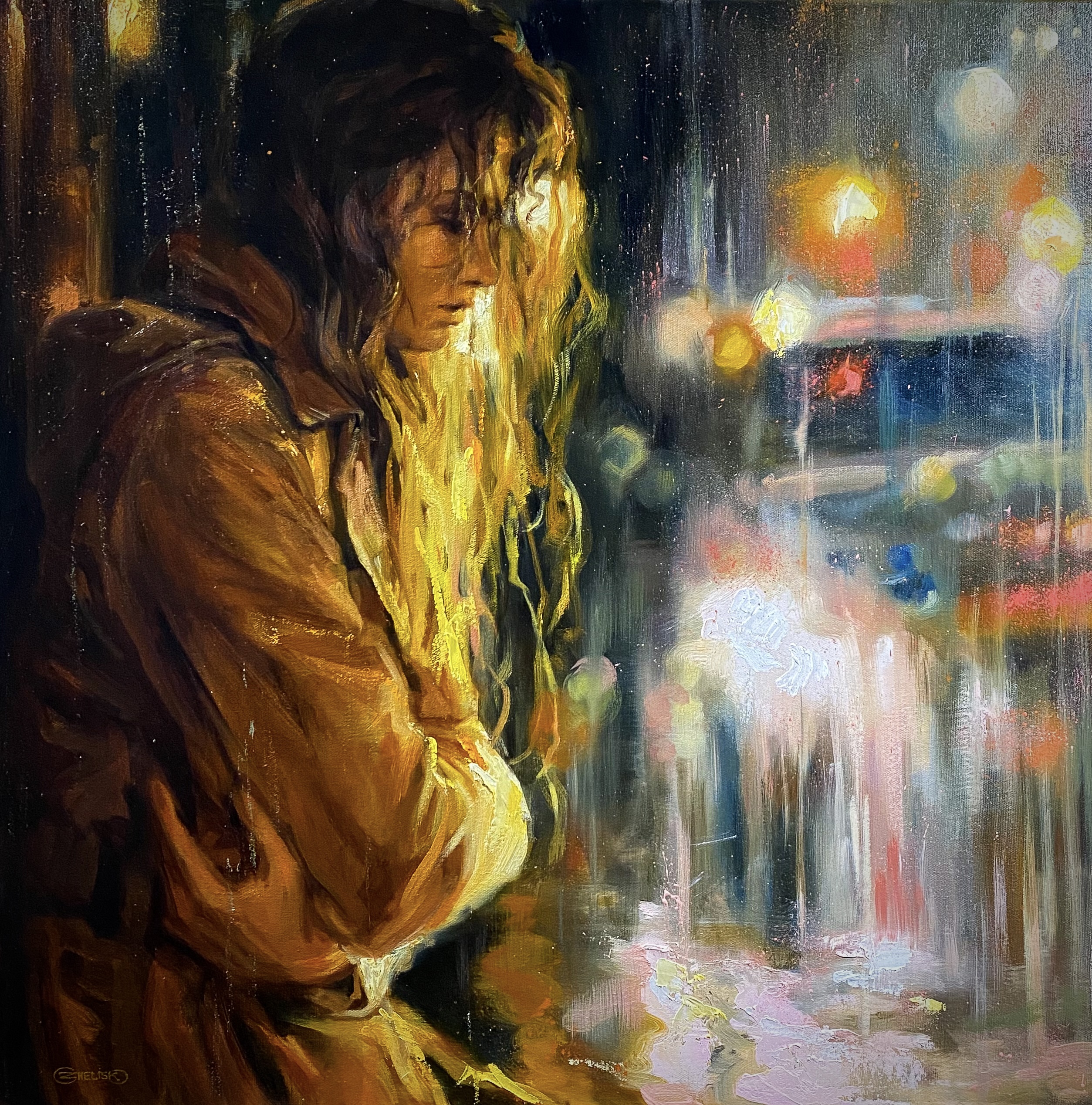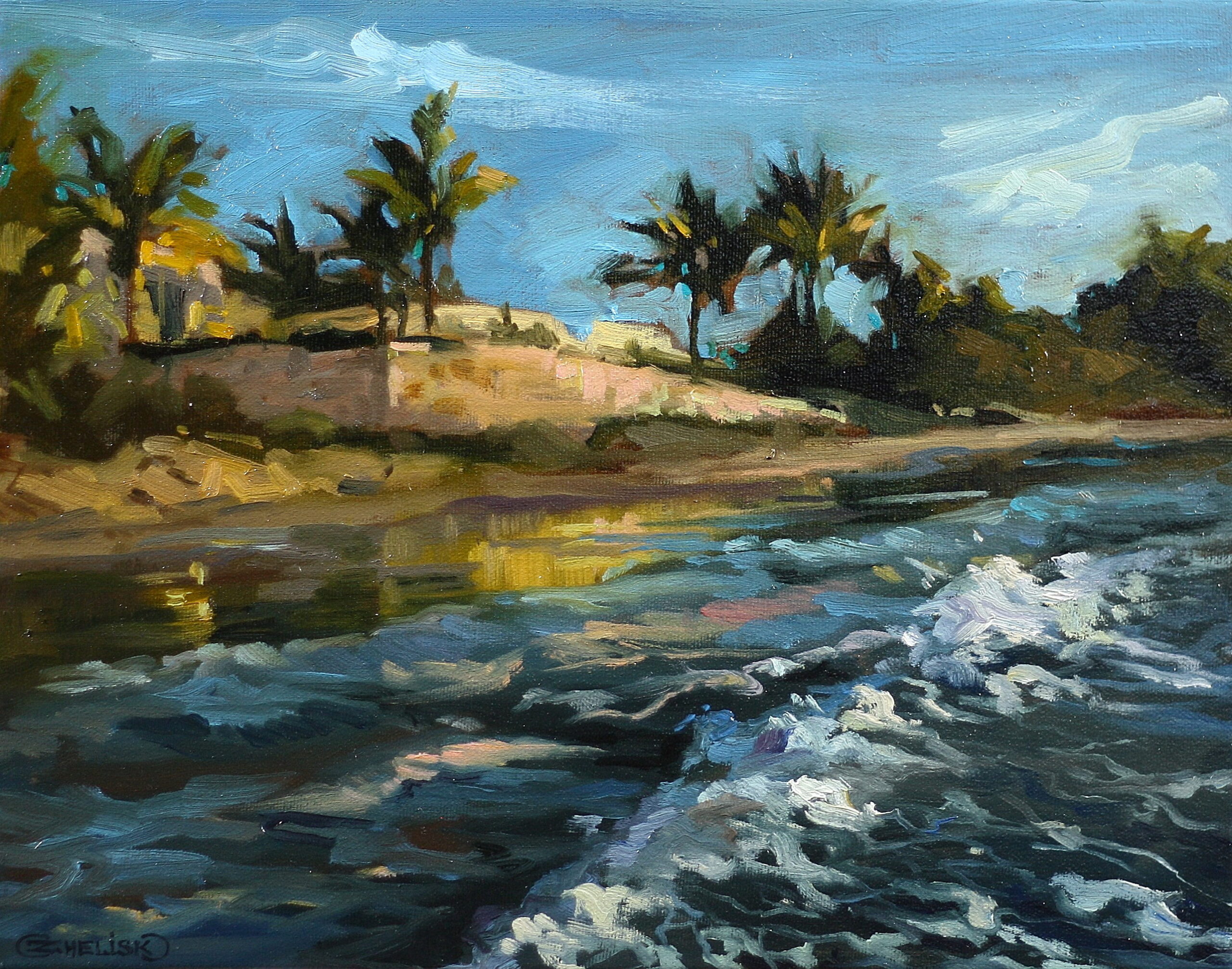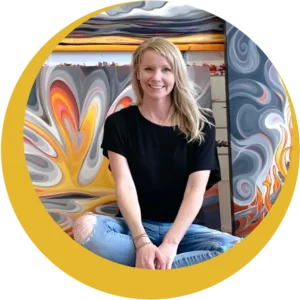HOW TO CRITIQUE YOUR OWN ARTWORK
LEARNING TO LOOK AT YOUR ART WITH AN OBJECTIVE EYE IS A TRICKY SKILL TO DEVELOP, BUT ONE OF THE MOST IMPACTFUL
Based on the Mastrius live event “The Art of the Self‑Critique” (November 20, 2025) with host Julie deBoer and mentors Oksana Zhelisko & Jason Lee Tako.

“The Fire Between Us” by Mastrius Mentor Jason Lee Tako
“The whole creative process is an endless series of critiques.” – Jason Lee Tako
Learning to look at your own work with an objective eye (not an emotional one) is a skill that takes time to develop.
It’s common to be overly critical of your own work. Many artists struggle with a loud “inner critic” and what we call “imposter syndrome” – the feeling that they’re faking it, their art is no good, that they can’t even call themselves an “artist”.
Others struggle to see their work objectively because they aren’t experts in composition, color theory, and design principles. If that’s you, you may look at your art and think, “something is off, but I have no idea what it is!”
Here’s what you need to know about the art of self-critique as you grow and develop as an artist.
KEY POINTS
- There are two types of critique: technical (composition, values, design) and contextual (intention, emotion, narrative). Both are important.
- Start every piece with a written intention and revisit it while working to stay aligned with your purpose.
- Use fresh-eye strategies: step back often, use a mirror reflection, hang your work and live with it for a few days to reveal issues more quickly.
- Technology is your friend: smartphone photos, greyscale conversions, and value checks help you assess structure and depth.
- Silencing the inner critic is essential: name three things you like every time you pause to critique. Develop a keen eye constructively and positively.
- Plan and isolate problems early: keep notes, practice thumbnails before you begin, do quick studies, limit variables, and rotate works in progress.

“Guardians of the Sacred Land” by Mentor Jason Lee Tako
There are two types of critique, and both are important.
First is the technical critique, it assesses the overall composition and design: from balance, to value, color, edges, shape, movement, variation, dominance, and the list goes on.
Second is the contextual critique, it’s equally important and considers the intention of the piece: the narrative, meaning, emotion, theme, symbolism, etc… the reason why you created it.
To critique your own work fairly, start by understanding your intention – what you want the piece to convey or say… its purpose. Always keep your intention in mind as you consider the technical success of your piece.
And don’t wait until the work is done to critique it. Step back often and assess it as you go!

“Forlorn” by Mentor Oksana Zhelisko
5‑STEP METHOD to the art of self‑critique.
1) Always Start with Your Intention
Write your intention for the piece in one sentence and keep it visible while you work. Read it often as you create so it keeps your heart in the game.
Every time you stop to critique ask yourself if the piece honors its purpose. What do you feel when you look at it? Is your eye drawn to the focal points. Is it telling the story well?
2) Pause Often for a Fresh‑Eye View
Step‑back often to view your piece from a distance, also look at its refection in a mirror and you’ll catch issues with balance and proportions quickly.
Hang it on a wall and live with it for a day or two. See what jumps out at you when you catch it in the corner of your eye. It can take time to develop a discerning eye, don’t rush the process.
3) Use Technology to Your Advantage
Use your smart phone to snap a photo, desaturate it into greyscale, and assess the overall value composition.
Is there depth or are there flat areas that need adjusting? Do the elements read clearly, or do they lose their form?
4) Silence the Inner Critic
Find 3 things you like about the piece, every time you stop to critique. You want to ensure you don’t overwork those areas, but more importantly, speaking positively about of your artwork is important for your confidence and growth. It can take practice to silence the inner critic, but it’s some of the most important work you’ll do.
5) Plan Your Way to Success
Write notes for yourself as you go. What did you struggle with? What problems kept surfacing? Before you start your next piece, review your notes and use what you learned as building blocks for your next piece.
TRY THIS: Start with a variety of thumbnail sketches in greyscale and color and think about the struggles from the last piece. Work out those challenges early and you’ll save yourself the frustrations of the past.
Here again we can see the effective use of depth creating SPACIOUSNESS in the work of Mentor Sandy Blass. Do you notice, as your eye moves through the piece, you’re drawn into, not just around the elements within the composition? From foreground to midground, to background and back again.
The implied sky space allows the eye to exit the scene without leaving the artwork. A beautiful narrative, wonderfully executed.
“Value is the most important thing. If the values are off, the work won’t have life.” – Oksana Zhelisko
What fundamentals should you check while you work?
There are many design elements and principles we can use to our advantage. Jason Lee Tako and Oksana Zhelisko summarized 5 ESSENTIALS that apply across all mediums.
• Focal Points: Establish a clear focal point and use the other elements to support it. Let secondary and tertiary focal points lead the eye back to the star of the show.
• Negative Space & Balance: Be mindful of the space around the elements and the overall balance: left to right, and top to bottom. Are the positive and negative shapes and spaces a variety of sizes? Is one visually heavy and creating a lop-sided composition?
• Values: Organize light, mid, and dark families. If the subject and elements read well in black & white, your structure is working. Want to create drama? Try a light or dark dominant value composition.
• Color: Control color value (light vs dark), saturation (vibrancy) and temperature (cool vs warm). Most color problems are related to the value of the color, not the color itself (the hue). Try a limited color palette until you feel comfortable with few colors, then add more.
• Edges: Use hard, soft, and lost edges to guide the eye. Remember the eye travels from soft edges toward hard edges. Use that to draw the eye toward your focal point.

“Setting” by Mastrius Mentor Oksana Zhelisko
How do you maintain fresh eyes & build your skill faster?
Change things up! Rotate works in progress so you can move to a different piece when one get’s frustrating or you feel stuck and want to avoid overworking it.
Problems will reveal themselves when you return to a piece after taking a break or working on another project.
Try this! Create 20–30‑minute studies with a limited palette and/or a big brush. Constrain one or two variables so decisions become clear and fast. It’s fun, freeing, and you’ll be surprised at what you’ll learn.
Isolate the problem. If you’re struggling with clouds then focus on clouds for a while. If your drawing skills are weak, stop painting or working with color for a while and draw from life. If color is weak, do color studies and ignore drawing for a bit.
Frequently Asked Questions
Can beginners self‑critique too?
Yes. Keep it simple: start with one clear focus: value‑only, edges‑only, or limited palette to build skills fast.
How often should I pause to review?
Make micro‑checks every few minutes. Check for too light, too dark, too warm, too cool. Then do step-back checks regularly – every hour or so. Look at overall balance and proportions. Near the end, slow down. Make fewer marks, stepping back more often.
How do I stay objective when social media is entirely subjective… and can feel discouraging?
Don’t measure quality by likes. Compare your piece to your intention and the fundamentals. Ask a trusted artist for feedback. Surround yourself with creatives at different stages so you can find your cheerleaders and give and receive feedback as you grow.
“Please don’t critique your work based on how many thumbs‑up you got online.” – Jason Lee Tako
IN SUMMARY
Critiquing your own artwork is about balancing technical analysis with contextual clarity. Many artists struggle with the sense that something feels “off” without knowing why. Understanding both your intention and the design fundamentals will help you evaluate your work more objectively and so you can make clearer creative decisions.
If you want to grow faster, learning the fundamentals from vetted master artist mentor will make all the difference. Mentorship will help you clarify your intention, understand your “why,” develop your artistic voice, see your work with fresh eyes, and build the confidence that only comes from guided feedback and support.
You don’t have to figure this out alone. Working alongside a mentor in a trusted small group of artist peers will accelerate your technical skills, strengthen your voice, and bring meaning into your creative process.
Keep on creating!
Julie deBoer
Artist & Founder

THE SECRET TO creating better art, faster, and with more joy…
Join a highly vetted Master Artist in Small Group Mentorship
Our Masters can see what you can’t yet. Get personalized feedback and critiques.
Choose from 180+ professional artist mentors excited to help you get to where you want to be.
Connect with like-minded artists in a non-competitive space.
Regular sessions and accountability keep you on track.
Save on art supplies, courses, and access live weekly events hosted by our Masters.
Join 100% RISK-FREE and cancel anytime.
Groups fill fast with LIMITED SPOTS. Don’t wait to find your Master Artist mentor.
Click below for full details and to view our roster of successful mentors making a living from their art.
